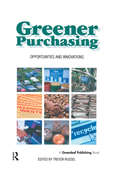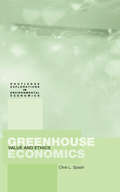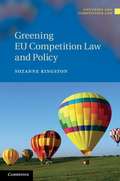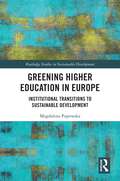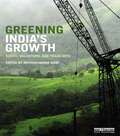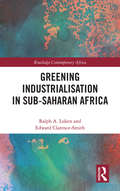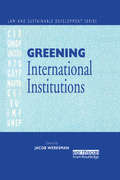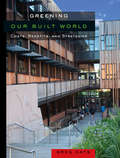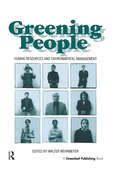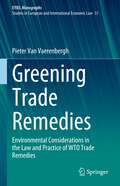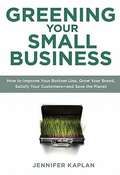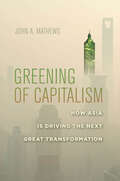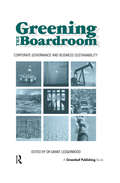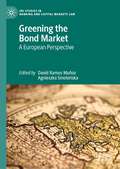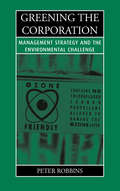- Table View
- List View
Greener Products: The Making and Marketing of Sustainable Brands, Second Edition
by Al IannuzziWritten by a renowned sustainability expert, Greener Products: The Making and Marketing of Sustainable Brands, Second Edition makes the case for why the people and the planet need products to be made in a different, more sustainable way. The growth of the global middle class, with an additional 3 billion people expected to enter the consumer market by 2030, is putting an unprecedented demand on resources and straining the global supply of raw materials, fossil fuels, food and water. This book provides insights on how to raise the bar on product development and investigates the best practices for making and marketing sustainable brands. Over 40 case studies are analyzed in this book and summarized for the reader to easily see what it is that makes leading companies successful. Analysis on marketing campaigns and greener product development range from leading companies like Apple, Nike, Samsung Electronics, BASF, GE, Johnson & Johnson, Unilever, and Method. New updated content in this second edition includes: New developments like the United Nations Sustainable Development Goals with concepts of biomimicry, circular economy, emerging issues management, and eco-innovation. Novel tools and examples for bringing sustainable products to market. New chapter dedicated to natural capital. Analysis of current green marketing methods and market trends. Best practices for making and marketing sustainable brands. For more information, visit the author's book website at www.greenerproducts.biz.
Greener Purchasing: Opportunities and Innovations
by Trevor RusselEvery organization, public and private, no matter what its size, purchases goods and services. Large organizations also have considerable influence over the practices of their suppliers. As greener purchasing practices have become more common in large organisations, the implications for companies in the supply chain have similarly increased. Yet greener purchasing policies remain the exception rather than the norm in large organizations. Why is this? And how can environmental purchasing practices that have produced tangible business benefits for a number of companies worldwide receive wider take-up? Greener Purchasing: Opportunities and Innovations has been published to facilitate the development and dissemination of best practice in environmental supply chain and procurement management worldwide. Divided into four sections, covering "The Public Sector", "The Private Sector", "Innovations" and "Case Studies", this book brings together international expertise from four continents, including contributions from organisations such as the US EPA, Environment Canada, Procter & Gamble, Xerox and The Body Shop, as well as describing burgeoning new initiatives such as the Japanese and European Green Purchasing Networks. It provides a number of checklists and examples on how to establish and maintain successful greener purchasing and supply chain practices in order to bring not only environmental, but business value to organisations of all sizes. The book is essential reading for purchasing officers, environmental managers, CEOs, consultants, academics and students interested in the topic around the world.
Greenergized: A Business Fable on Clean Energy
by Dennis PosadasRenewable energy versus fossil fuels: the debate rages on, worldwide. At stake is nothing less than the protection of our planet from the ravages of climate change. But the costs involved in making the switch to clean energy are daunting. How do we pay for solar and wind energy? Do we scrap all our gasoline-driven autos? How do we move forward?Although the importance of this topic is hard to overstate, it nevertheless consistently fails to engage at the level that it so patently needs to. This is what has led technology expert and seasoned commentator Dennis Posadas to approach the issues in a new and intriguing way. Posadas understands that we respond best to narratives, and that is why he has written what he describes as a "green thinking fable". In this fable, we meet Daniel, a young graduate of the fictional Oriental College, who is thrust into a debate between José, an oil man, and Professor Ruiz, an advocate of clean energy. We follow the lines of argument as Daniel's awareness increases, and he experiences a paradigm shift in his thinking. We see how his short-term outlook focusing on the cost of renewable energy evolves into long-term thinking about the cost of not making the shift to renewables. Posadas's business fable puts the issues in front of the general reader in an engaging and digestible way. It covers concepts such as solar, wind, electric vehicles, waste to energy, feed-in-tariffs, carbon tax, intermittent sources, cost of fossil fuels, health impact of fossil fuel use, energy efficiency, and other relevant topics necessary for understanding this debate. The story and characters may be fictional, but the situations and the technology discussions are based on current facts. Decide for yourself where you stand on the renewables versus fossil fuels debate, and discuss this story with your friends and colleagues. Greenergized is a much-needed route into the issues surrounding the most serious debate our generation faces. And it pulls off the brilliant trick of being highly readable at the same time.
Greenhouse Economics: Value and Ethics
by Clive SpashExamining one of the most crucial issues in the modern world: human induced climate change, here Clive Spash provides a refreshing interdisciplinary perspective, pulling together strands of natural science, economics and ethics. Described by John Gowdy as ‘the best exposition to date on the political economy of climate policy’, this remarkable volume poses serious questions and gives intelligent answers. The issues it addresses are relevant to a range of environmental problems, and it covers themes such as:How do we deal with uncertainty and ignorance?What roles do science and economics play in policy formation?To what extent should individuals take responsibility for the society in which they and their descendants live?By rigorously examining international and governmental sources, and key contemporary issues, Spash provides an up-to-date and informative analysis. A well-organized study (including a glossary and helpful acronym list), this book will be of strong interest to students and academics in the fields of ecological and environmental economics, and is essential reading for all those to whom climate change is a professional or personal concern.
Greening Airports
by Milan JanićGreening Airports considers the "greening", i.e., more sustainable development, of the entire air transport system - airports, air traffic control, and airlines - that could be achieved by the development and implementation of advanced operations and technologies. A broad overview of the general concept is given at the start of Greening Airports, which then goes on to provide a system for monitoring and assessing the level of greening of both the air transport system and individual airports. These are followed by analysis and modelling of the potential effects of particular advanced operations and technologies on the greening of airports and their local airspace. These include: the development of a large airport into a multimodal transport node by connecting it to a high speed rail network;the use of operations supported by new and existing air traffic control technologies to increase landing capacity of existing runways;the use of liquid hydrogen as a commercial aviation fuel; andthe improvement of airport ground accessibility by a light rail rapid transit system. Greening Airports is written for researchers, planners, operators and policy makers in air transport.
Greening China: The Benefits of Trade and Foreign Direct Investment
by Ka Zeng Joshua Eastin"The authors make some very critical interventions in this debate and scholars engaged in the environmental 'pollution haven' and 'race to the bottom' debates will need to take the arguments made here seriously, re-evaluating their own preferred theories to respond to the insightful theorizing and empirically rigorous testing that Zeng and Eastin present in the book. " -Ronald Mitchell, University of Oregon China has earned a reputation for lax environmental standards that allegedly attract corporations more interested in profit than in moral responsibility and, consequently, further negate incentives to raise environmental standards. Surprisingly, Ka Zeng and Joshua Eastin find that international economic integration with nation-states that have stringent environmental regulations facilitates the diffusion of corporate environmental norms and standards to Chinese provinces. At the same time, concerns about "green" tariffs imposed by importing countries encourage Chinese export-oriented firms to ratchet up their own environmental standards. The authors present systematic quantitative and qualitative analyses and data that not only demonstrate the ways in which external market pressure influences domestic environmental policy but also lend credence to arguments for the ameliorative effect of trade and foreign direct investment on the global environment.
Greening Chinese Business: Barriers, Trends and Opportunities for Environmental Management
by Ulrich Steger Lu Wei Fang ZhaobenThis work analyses and interprets Chinese managers' perceptions of environmental management and regulatory enforcement practices in Chinese enterprises. Most importantly, it identifies the bottlenecks to environmental protection in Chinese firms, and presents a roadmap of how they can be overcome.
Greening Citizenship
by Andy ScerriThe greening of citizenship, the state and ideology has created both opportunities and bottlenecks for progressive political movements. Scerri argues that these are pursuing justice by making holistic demands for: fair distribution and status recognition, adequate representation and effective participation.
Greening EU Competition Law and Policy
by Suzanne KingstonOne of the fundamental challenges currently facing the EU is that of reconciling its economic and environmental policies. Nevertheless, the role of environmental protection in EU competition law and policy has often been overlooked. Recent years have witnessed a shift in environmental regulation from reliance on command and control to an increased use of market-based environmental policy instruments such as environmental taxes, green subsidies, emissions trading and the encouragement of voluntary corporate green initiatives. By bringing the market into environmental policy, such instruments raise a host of issues that competition law must address. This interdisciplinary treatment of the interaction between these key EU policy areas challenges the view that EU competition policy is a special case, insulated from environmental concerns by the overriding efficiency imperative, and puts forward practical proposals for achieving genuine integration.
Greening Higher Education in Europe: Institutional Transitions to Sustainable Development (Routledge Studies in Sustainable Development)
by Magdalena PopowskaThis book provides a comprehensive overview of the advances that have taken place in European higher education institutions (HEIs) over the last 20 years in response to the challenges of sustainable development.In recent years, there has been a visible shift toward sustainable development, and universities have been addressing their accountability to the public through corporate social responsibility. Greening Higher Education in Europe explores these recent developments, beginning with an introduction to sustainable development and its complexity, followed by a discussion of the regulatory and organizational context of higher education in Europe. This book goes on to examine the key pillars of sustainable development in HEIs, including education, research, and campus development, demonstrating best practices from a range of European universities including the University of Groningen (The Netherlands), Lund University (Sweden), Aalto University (Finland), and The University of Edinburgh (UK), among others. It also explores the role of HEIs in educating future leaders in sustainable development and presents a framework for understanding the values and decision-making processes of HEI leaders. It concludes by highlighting the need for a new paradigm in HEIs that promotes innovation, quality, equity, and respect for the environment.This book will be useful for scholars and academic professionals from a wide variety of disciplines, including sustainability, especially in its educational, research, and practical (applied) dimensions. It will also be a useful resource for postgraduate students in management and engineering.
Greening India's Growth: Costs, Valuations and Trade-offs
by Muthukumara S. ManiIndia’s sustained and rapid economic growth offers an opportunity to lift millions out of poverty. But this may come at a steep cost to its environment and natural resources. This insightful book analyses India’s growth from an economic perspective and assesses whether India can grow in a "green" and sustainable manner. Three key issues are addressed. The first is the physical and monetary costs and losses of environmental health and natural resources driven by economic growth. The authors undertake a monetary valuation and quantification of environmental damage, using techniques that have been developed to better understand and quantify preferences and values of individuals and communities in the context of environmental quality, conservation of natural resources, and environmental health risks. The second part estimates the value of ecosystem services from the major biomes in India using state-of-the art methods with a view to preserving them for the future. The third section provides a menu of policy instruments to explore trade-offs between economic growth and environmental sustainability using a Computable General Equilibrium approach with particular attention to air pollution. The conclusions focus on the way forward in terms of policies, measures and instruments as India has to balance the twin challenges of maintaining economic prosperity while managing its environmental resources.
Greening Industrialization in Sub-Saharan Africa (Routledge Contemporary Africa)
by Ralph Luken Edward Clarence-SmithThis book explores the concept of greening industrialization and issues and considerations surrounding it through the lens of Sub-Saharan Africa. The book critically examines the concept of greening industrialization and describes the progress and data challenges of monitoring the Sustainable Development Goals confronting African countries. The chapters summarize the policy and programme literature focused on eight policy regimes essential for greening industrialization and identify opportunities for greening industrial policies. The authors lay out a research agenda that would inform, enable and support greening industrialization in Sub-Saharan Africa and provide an overview of green industrial plans that include climate strategies, energy efficiency strategies and green industry assessments. This book will be of great interest to students, scholars, policy makers and planners in the fields of Sub-Saharan Africa development and African environmentalism.
Greening International Institutions
by Jacob WerksmannEnvironmentally sustainable development has become one of the world's most urgent priorities. But countries cannot achieve it alone: it depends on international coordination and action. Greening International Institutions, the latest in a series of highly-acclaimed publications devoted to environmental and developmental law, assesses how far and how successfully intergovernmental organizations have responded to the challenge. The organizations analyzed include: the UN General Assembly, the new Commission for Sustainable Development, UNEP, UNDP and UNCTAD, WTO, GATT, NAFTA, the Bretton Woods institutions and several regional bodies, as well as treaty bodies and the mechanisms for avoiding and settling disputes. For each, the contributors provide an accessible overview of the organization's mandate and structure, examine substantive policy initiatives and assess the need and scope for procedural and institutional reform. Drawing together a collection of essays by lawyers and researchers from various backgrounds, Greening International Institutions is stimulating reading for students and policy-makers, as well as anyone concerned with the development of international institutions. Jacob Werksman is an attorney, a Programme Director at FIELD, and Visiting Lecturer in International Economic Law at the University of London. Greening International Institutions is the fifth volume in the International Law and Sustainable Development series, co-developed with FIELD. The series aims to address and define the major legal issues associated with sustainable development and to contribute to the progressive development of international law. Other titles in the series are: Greening International Law, Interpreting the Precautionary Principle, Property Rights in the Defence of Nature and Improving Compliance with International Environmental Law. 'A legal parallel to the Blueprint series - welcome, timely and provocative' David Pearce Originally published in 1996
Greening Our Built World: Costs, Benefits, and Strategies
by Greg Kats"Green" buildings--buildings that use fewer resources to build and to sustain--are commonly thought to be too expensive to attract builders and buyers. But are they? The answer to this question has enormous consequences, since residential and commercial buildings together account for nearly 50% of American energy consumption--including at least 75% of electricity usage--according to recent government statistics. This eye-opening book reports the results of a large-scale study based on extensive financial and technical analyses of more than 150 green buildings in the U.S. and ten other countries. It provides detailed findings on the costs and financial benefits of building green. According to the study, green buildings cost roughly 2% more to build than conventional buildings--far less than previously assumed--and provide a wide range of financial, health and social benefits. In addition, green buildings reduce energy use by an average of 33%, resulting in significant cost savings. Greening Our Built World also evaluates the cost effectiveness of "green community development" and presents the results of the first-ever survey of green buildings constructed by faith-based organizations. Throughout the book, leading practitioners in green design--including architects, developers, and property owners--share their own experiences in building green. A compelling combination of rock-solid facts and specific examples, this book proves that green design is both cost-effective and earth-friendly.
Greening People: Human Resources and Environmental Management
by Walter WehrmeyerThis major collection examines both the human resource dimensions of environmental management and how environmental management impacts on human resource departments. Contributions from international experts in both academia and business look at current theory and best practice in environmental TQM, education, training and communications. Greening People argues that, if a company is to adopt an environmentally-aware approach to its activities, the employees are the key to success or failure. Realistically, it is only through the energy, performance and personal commitment of each employee within an organization that business will move towards sustainable industrial development. This book provides an important angle on the new complexities faced by environmental managers and human resource professionals and offers practical solutions drawn from some of the leading lights in the corporate environmental revolution. Greening People is divided into four parts. Part 1 demonstrates the relationship between human resource management and environmental management. Part 2 provides insight into the psychological make-up of contemporary staff that may foster or hinder company-wide implementation of environmental measures, and Part 3 addresses the shortcomings of current management training programmes and suggests new approaches for effective implementation of environmental human resource management. Finally, a selection of excellent case studies demonstrates how the concepts are being implemented in companies and local authorities.
Greening Trade Remedies: Environmental Considerations in the Law and Practice of WTO Trade Remedies (European Yearbook of International Economic Law #31)
by Pieter Van VaerenberghThis book explores the role of trade remedies in liberalising environmental trade and discouraging environmentally harmful trade. As trade remedies can pose a significant obstacle to environmental trade, this book outlines how trade negotiators can implement restrictions on the application of trade remedies on environmental goods. It also assesses whether and how investigating authorities can account for differences in environmental protection standards in trade remedy investigations and considers what a possible 'trade remedy' for environmental harm might look like. Although the book concludes that trade remedies will remain a trade instrument primarily driven by economic and competitiveness concerns, it demonstrates how environmental considerations can guide trade remedy policy, how investigating authorities can properly account for the environmental costs of production, and how the limited policy space available in the WTO Agreements on Trade Remedies can be used to pursue green policy goals.
Greening Trade and Investment: Environmental Protection Without Protectionism
by Eric NeumayerA comprehensive, critical analysis of the interactions between investment, trade and the environment. It examines the consequences of existing multilateral investment and trade regimes, including the WTO and the MAI for the environment, and asks how they should be reformed to protect it. In doing so, the text shows how these regimes can be greened without erecting protectionist barriers to trade that frustrate the development aspirations of poorer countries. The solution seeks to offer a way out of one of the most difficult dilemmas in international policy: how investment and trade can protect the environment without encouraging protectionism by the industrialized world.
Greening Walmart: Progress and Controversy
by James Weber Rebecca M HendersonIn 2005, Walmart, the world's largest retailer, launched a sustainability initiative aimed at reducing waste and making the company more environmentally and socially conscious. By 2015, the company had made progress on multiple dimensions: energy efficiency in its stores and its supply chain, lower levels of greenhouse gas emissions, safer products for customers and manufacturers, and better treatment of its workers. The company promoted the idea that its size gave it significant influence in the economy and that if it took steps to operate more sustainably, and demanded its suppliers do the same, this would have an impact on its own bottom line and make the world a better place for everyone. Students can explore whether Walmart is making these changes to improve its battered public image, improve its bottom line, or because it is the right thing to do.
Greening Your Office
by Jon Clift Amanda CuthbertAn A-to-Z guide for offices of all sizes, from energy use and better supply purchases to recycling and reusing materials, plus summaries of a range of renewable energy options, commuting techniques, and more. These tips help your workplace save money while reducing environmental impacts, and can boost employee morale in the process. Your choices for coffee, computer monitors, furniture, invoices, lighting, paper, stamps, and hundreds of other items can add up to a better world.
Greening Your Small Business
by Jennifer KaplanThe ultimate resource for small business owners who want to go green without going broke. Greening Your Small Business is the definitive resource for those who want their small businesses to be cutting- edge, competitive, profitable, and eco-conscious. Filled with stories from small business owners of all stripes, Greening Your Small Business addresses every aspect of going green, from basics such as recycling, reducing waste, energy efficiency, and reducing the IT footprint, to more in-depth concerns such as green marketing and communications, green business travel, and green employee benefits. For companies too small to hire consultants to draft and implement green policies and practices, this guide is designed for easy use, featuring: ? Simple ways to make the workplace greener ? Two plans of action for going green (divided into two levels) ? Definitions for green terminology and jargon .
Greening of Capitalism: How Asia Is Driving the Next Great Transformation
by John A. MathewsAs China, India, and other industrializing giants grow, they are confronted with an inconvenient truth: They cannot rely on the conventions of capitalism as we know them today. Western industrialism has achieved miracles, promoting unprecedented levels of prosperity and raising hundreds of millions out of poverty. Yet, if allowed to proceed unencumbered, this paradigm will do irreversible harm to the planet. By necessity, a new approach to environmentally conscious development is already emerging in the East, with China leading the way. Positioning its argument against zero-growth advocates and free-market environmentalists, Greening of Capitalism charts this transformation and sketches out a framework for more sustainable capitalism. State-mandated changes in energy use (as opposed to carbon taxes), a circular flow of resources (as opposed to emissions standards), and the introduction of new financial instruments that support green growth are cornerstones of China's framework. John A. Mathews argues that these tenets will be emulated around the world—first in India and Brazil. In light of this emerging shift, Mathews considers core debates over national security, international relations, and economic policy, ultimately addressing the question of whether these measures will be far-reaching or timely enough to prevent further damage.
Greening the Boardroom: Corporate Governance and Business Sustainability
by Grant LedgerwoodOn a world scale, the implicit deal between corporation and community is undergoing a revolution in the period 1990–2000. For the first time, corporate boardrooms are having to confront the environmental challenge not as a peripheral issue around "public relations", but as a core issue of credibility with its customers. As trust in big business has declined, consumer willingness to alter buying behaviour to register disapproval has accelerated. As a result, boardrooms in the largest companies are having to redraw their strategic procedures regarding the environment. This book aims to advance the general understanding of corporate environmental governance as an issue capable of separate and detailed analysis. It aims to provide not an overview, but a series of test cores into the generally unexamined issues surrounding the changing ethos of corporate action and environmental investment. To date, the "business and environment" strategic conversation has reached only a minute proportion of a global audience. Over the next twenty years, this dialogue will transform business into the 21st century. Moreover, it will become internalised into a way of working within Corporate Culture. Greening the Boardroom explores through case studies and surveys some of the changes in this process, in Europe as well as in Asia and North America. Suitable for readers in general management, business, government and academia, this book is an important contribution to the corporate environmental debate by the author of The Environmental Audit and Business Strategy: A Total Quality Approach.
Greening the Bond Market: A European Perspective (EBI Studies in Banking and Capital Markets Law)
by David Ramos Muñoz Agnieszka SmoleńskaGreen bond issuance has surged in recent years in response to growing investor appetite and borrowers' needs as they embark on the sustainability transition. The EU leads the way, with over 40% of all sustainable bond issuances denominated in euro. The EU’s 'Regulation on European Green Bonds and optional disclosures for bonds marketed as environmentally sustainable and sustainability-linked bonds’ is the first comprehensive legislative text covering such issuance, and a cornerstone of EU’s Sustainable Finance strategy. This book explores in an interdisciplinary way the challenges and opportunities of green bonds and sustainable finance from a legal, regulatory and economic perspectives. First, it analyses green bonds as a new financial instrument in the context of the existing capital markets law. Second, it studies green bond impact on the market and on investor protection. Third, it assesses green bonds’ relevance for prudential supervision and central banking. The variety of viewpoints ensures a highly comprehensive analysis of green bonds’ impact in a European and global context.
Greening the College Curriculum: A Guide To Environmental Teaching In The Liberal Arts
by David Campbell Holmes Rolston Vern Durkee Ann Filemyr Jonathan Collett William BaléeGreening the College Curriculum provides the tools college and university faculty need to meet personal and institutional goals for integrating environmental issues into the curriculum. Leading educators from a wide range of fields, including anthropology, biology, economics, geography, history, literature, journalism, philosophy, political science, and religion, describe their experience introducing environmental issues into their teaching.The book provides: a rationale for including material on the environment in the teaching of the basic concepts of each discipline guidelines for constructing a unit or a full course at the introductory level that makes use of environmental subjects sample plans for upper-level courses a compendium of annotated resources, both print and nonprint Contributors to the volume include David Orr, David G. Campbell, Lisa Naughton, Emily Young, John Opie, Holmes Rolston III, Michael E. Kraft, Steven Rockefeller, and others.
Greening the Corporation: Management Strategy and the Environmental Challenge
by Peter Thayer RobbinsCorporate responses to environmental challenges are often held directly or indirectly responsible for significant worldwide environmental destruction. Corporations are beginning to respond to environmental and social concerns and are taking these into account. This process, known as the greening of the corporation is fraught with contradictions since the foremost aim of corporations is to earn profits. Robbins analyses the approaches of four major international companies: ARCO Chemical; Ben & Jerry's; Shell; and The Body Shop.

